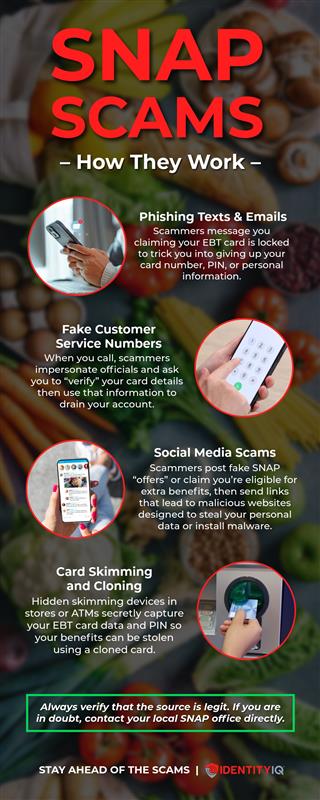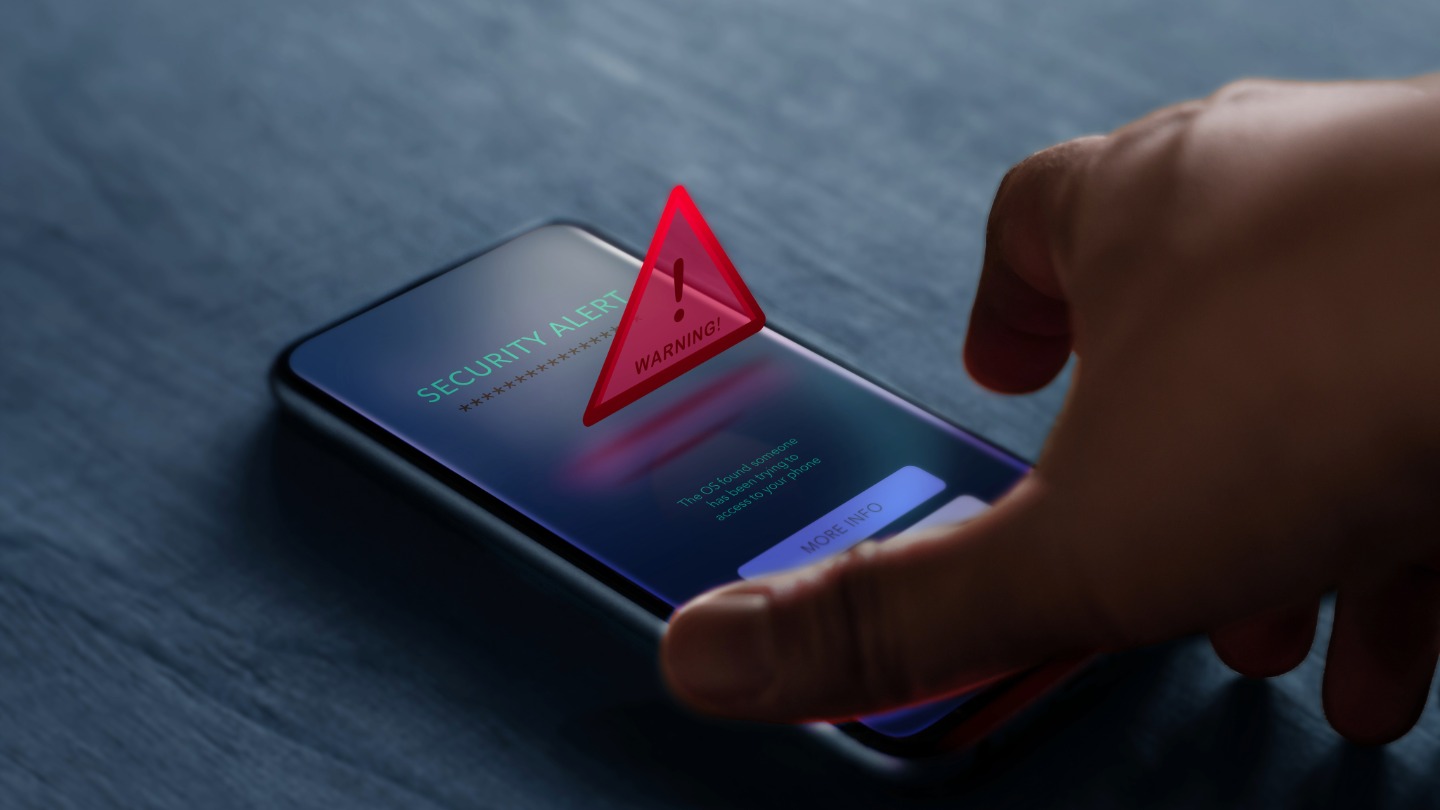
Millions of Americans rely on the Supplemental Nutrition Assistance Program (SNAP), commonly known as food stamps, to help feed their families. But as those in need depend on these essential benefits, scammers see them as an opportunity to steal money and personal information.
Criminals targeting SNAP benefits has increase an astonishing 55% in the final quarter of last year and first quarter of this year, according to a recent U.S. Department of Agriculture (USDA) Food and Nutrition Service report. The rise of SNAP benefit scams can be scary, especially if you or someone you love depends on SNAP.
It’s essential to understand how these scams work. Here’s how scammers target SNAP, the most common SNAP scams happening today, and steps you can take to spot and avoid Electronic Benefits Transfer (EBT) fraud.

Why Are SNAP Benefits a Target for Scammers?
Criminals love easy money, and, unfortunately, SNAP benefits provide a direct line to government-issued funds. Unlike other forms of fraud that may require setting up fake bank accounts or more sophisticated scams, EBT fraud can be as simple as stealing a card number and personal identification number (PIN).
For many families, every dollar of SNAP benefits counts. That financial vulnerability can make SNAP recipients prime targets for phishing, card skimming, and other scams that can drain their accounts and disrupt their ability to buy groceries.
How Do SNAP Scams Work?
Scammers are always coming up with new ways to trick people into handing over their personal information. For those who receive SNAP benefits, this includes EBT card details. Below are some of the most common scams to watch for:
1. Phishing Texts and Emails
One of the biggest threats to people who use SNAP benefits is phishing scams. Criminals send fake texts, emails, or direct messages that look like they come from your local SNAP office or a government agency.
These messages can claim your EBT card has been locked, suspended, or compromised. They tell you to click a link or call a fake customer service number. Once you do, you are asked to enter your card number, PIN, Social Security number, or other personal information.
With your personal information, scammers can drain your SNAP balance or use your identity to commit further fraud.
Red flags to look out for:
- Unsolicited messages about your EBT card.
- Urgent threats that your benefits are locked or will be frozen.
- Requests for your PIN or card number through text, email, or social media.
2. Fake Customer Service Numbers
Some phishing texts and emails direct you to fake “help lines.” These fake numbers connect you to scammers pretending to be government representatives. They’ll ask you to “verify” your card details and other personal information. Then, they access your account and steal your money and commit other fraud.
Always contact the SNAP program through an official number. Your local SNAP office’s contact information is available on verified USDA government websites.
3. Social Media Scams
Fraudsters also exploit social media platforms. Some scammers promise free money or instant cash if you “sign up” for special SNAP offers through their pages or groups.
Other SNAP benefit scams target college students with messages saying they’re automatically eligible for SNAP benefits. They tell you all you have to do is click a link and provide your personal details.
In reality, these links lead to fraudulent websites designed to steal your information or install malware on your device.
4. Card Skimming and Cloning
Not all scams happen online. Card skimming devices can be secretly attached to point-of-sale machines or ATMs where you swipe your EBT card. These devices capture your card information and PIN without your knowledge. Scammers then clone your card and drain your balance.
To protect yourself, inspect card readers for signs of being tampered with and protect your PIN when you enter it.
Signs You May Be Targeted by a SNAP Scam
Scammers constantly change their tactics, but many scams share the same warning signs.
Watch for these red flags:
- Messages with spelling errors or generic greetings like “Dear SNAP Customer.”
- Requests for your card number, PIN, or personal information through unsolicited text, email, or social media.
- Pressure to act immediately to avoid losing benefits.
- Promises of free money or “special offers” in exchange for entering your card information.
- Unfamiliar links that direct you to unofficial websites.
If something feels off, trust your instincts, stop, and verify.
How to Avoid SNAP Benefit Scams
Protecting your SNAP benefits starts with a few simple steps to help keep your information safe.
1. Never Share Your EBT Card Details
Your EBT card number and PIN should be treated like your bank account. No legitimate SNAP office will ever ask you to share your PIN or card number through text, email, or over social media. Keep this information private.
2. Don’t Click Unverified Links
If you receive a message claiming your EBT card is locked, don’t click any links. Go directly to your state’s official SNAP website or call your local SNAP office using a verified official phone number.
3. Always Verify Suspicious Messages
If you get a suspicious email, text, or phone call about your SNAP benefits, verify it through official channels. Look up your state’s SNAP contact information online or go into your local office. Only contact them through official channels.
4. Check Your Account Regularly
Log in to your EBT account frequently to monitor for unauthorized transactions. If you spot something unusual, report it immediately to your local SNAP office.
5. Be Cautious at Checkout
Before swiping your EBT card at stores or ATMs, inspect the machine for signs of tampering, loose parts, or unusual attachments. When entering your PIN, shield the keypad with your hand to prevent people or hidden cameras from capturing your PIN.
6. Use Identity Theft Protection Services
One of the best ways to help protect yourself from scams that can lead to identity theft is to use a trusted identity theft protection service. Identity theft often starts with stolen information, like your EBT card number, PIN, or Social Security number, and can lead to hundreds if not thousands of lost funds.
IdentityIQ identity theft protection services offer real-time credit monitoring, dark web scanning, and identity restoration services to help you stay a step ahead of criminals and minimize the damage if your information is ever compromised.
IdentityIQ is an award-winning leader in identity theft monitoring. IdentityIQ has been named the best comprehensive identity theft protection choice by Smartech Daily.
What to Do If You Fall for a SNAP Benefits Scam
Mistakes happen, and scammers are skilled at tricking people into sharing their personal information. If you believe you’ve fallen victim to a SNAP scam:
- Contact your local SNAP office immediately. They may be able to freeze your card or issue a replacement to prevent further loss.
- Change your PIN right away. Even if you’re unsure, it’s better to be safe.
- File a police report if necessary. This creates a record of the fraud.
- Report the scam to the USDA Office of Inspector General by calling 1-800-424-9121 or visiting USDA Office of Inspector General’s website.
Stay Informed to Stay Safe
Criminals will always try to exploit new ways to steal from people. Staying informed about the latest SNAP scams and taking simple precautions can help protect your benefits and your peace of mind.
Remember:
- Official agencies never ask for your PIN by text, email, or phone.
- It’s safer to verify than risk losing your benefits to fraudsters.
- If you are in doubt, contact your local SNAP office directly.
By spreading the word, you can also help protect those who rely on SNAP benefits.
Protect Your Identity Today
Being aware and being vigilant is essential when it comes to spotting and avoiding SNAP benefit scams. While these scams are on the rise, you don’t have to face them alone.
Identity theft protection can help catch fraud early and restore your peace of mind if scammers get your information. Get protected with IdentityIQ today.



.png)



